Beijing Capital International Airport
Beijing Capital International Airport,is the main international airport that serves the capital city of Beijing, People's Republic of China. The IATA Airport Code is PEK, reflecting Beijing's former Romanization Peking. The airport is located 20km to the north-east of the Beijing city-center. Although many consider it to lie in Shunyi District, it is, in fact, an exclave of Chaoyang District, Beijing.
The airport is a primary hub of operations for Air China, which flies to around 120 destinations (excluding cargo). It is also a hub for Hainan Airlines and China Southern Airlines. The airport expansion is largely funded by a 500-million-euro (USD 625 million) loan from the European Investment Bank (EIB). The loan is the largest ever granted by the EIB in Asia; the agreement was signed during the eighth China-EU Summit held in September 2005.
Beijing Airport was opened on March 2, 1958. The airport then consisted of one small terminal building, which still stands to this day, apparently for the use of VIPs and charter flights. On January 1, 1980, a newer, larger building - green in colour - opened, with docks for 10 to 12 aircraft. The terminal was larger than the one in the 1950s, but by the mid-1990s, it was too small. The terminal was then closed for renovation after the opening of Terminal 2.
In late 1999, to mark the 50th anniversary of the founding of the PRC, the airport was expanded again. This new terminal opened on November 1, and was named Terminal 2. September 20, 2004, saw the opening of a new Terminal 1 for a few airlines, including China Southern Airlines' domestic and international flights from Beijing. Other airlines' domestic and international flights still operate in Terminal 2.
Beijing Airport was opened on March 2, 1958. The airport then consisted of one small terminal building, which still stands to this day, apparently for the use of VIPs and charter flights. On January 1, 1980, a newer, larger building - green in colour - opened, with docks for 10 to 12 aircraft. The terminal was larger than the one in the 1950s, but by the mid-1990s, it was too small. The terminal was then closed for renovation after the opening of Terminal 2.
In late 1999, to mark the 50th anniversary of the founding of the PRC, the airport was expanded again. This new terminal opened on November 1, and was named Terminal 2. September 20, 2004, saw the opening of a new Terminal 1 for a few airlines, including China Southern Airlines' domestic and international flights from Beijing. Other airlines' domestic and international flights still operate in Terminal 2.
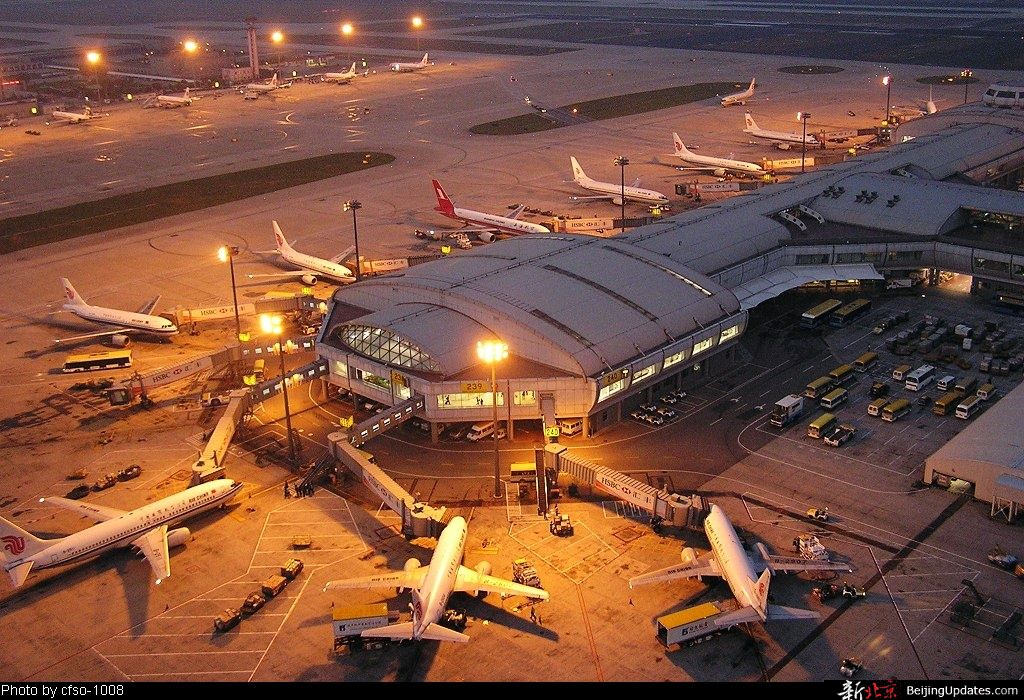 Photo by foxoniu
Photo by foxoniuAnother expansion, Terminal 3 (T3) was completed in February 2008, in time for the Beijing Olympics. This colossal expansion includes a third runway and another terminal for Beijing airport, and a rail link to the city-center. At its opening, It was the largest man made structure in the world in terms of area covered, and a major landmark in Beijing representing the growing and developing Chinese city. The third runway of BCIA opened on October 29, 2007, to relieve congestion on the other two runways.
Fresh from hosting the 2008 Olympic Games and completion of its new terminal building, The Beijing Capital International has overtaken Tokyo Haneda to be the busiest airport in Asia based on scheduled seat capacity.
Fresh from hosting the 2008 Olympic Games and completion of its new terminal building, The Beijing Capital International has overtaken Tokyo Haneda to be the busiest airport in Asia based on scheduled seat capacity.
Terminal 1, with 60,000 square meters of space, was opened on January 1, 1980, and replaced the small existing terminal which was in operation since the 1950s. The Terminal was closed for renovation from 1999 to September 20, 2004, during which all airlines operated from Terminal 2. Featuring 16 gates, it was the operational base for China Southern Airlines' domestic routes and a few other airlines such as Xiamen Airlines and Chongqing Airlines, and was originally planned to handle domestic traffic, excluding those to Hong Kong and Macau. With the opening of Terminal 3, the terminal was closed for light refurbishment, and its airlines were moved to Terminal 2 on May 20, 2008.
Terminal 2 opened on November 1, 1999, a month after the 50th anniversary of the founding of the People's Republic of China. This terminal was used to replace Terminal 1 while the later was undergoing renovation, cramping all airlines into this terminal despite it being far bigger than Terminal 1 and can handle twenty airplanes at docks connecting directly to the terminal building. Prior to the opening of Terminal 3, the majority of the flights from PEK operated from this terminal. This terminal now houses China Southern Airlines, China Eastern Airlines, Skyteam, and other domestic and international flights after Air China, Shanghai Airlines, Star Alliance members, Oneworld members moved operations to the new Terminal 3.
Construction of Terminal 3 started on March 28, 2004, and was opened in two stages. Trial operations commenced on February 29, 2008, when seven airlines, namely British Airways, El Al Israel Airlines, Qantas, Qatar Airways, Shandong Airlines and Sichuan Airlines moved into the terminal. 20 other airlines moved into the terminal when it became fully operational on March 26, 2008. Currently, it mainly houses Air China, Oneworld, Star Alliance, and other domestic and international flights.

It was designed by a consortium of NACO (Netherlands Airport Consultants B.V), UK Architect Foster and Partners and ARUP. The budget of the expansion is US$3.5 billion. Far grander in size and scale than the existing terminals, it was the largest airport terminal-building complex built in a single phase with 986,000 square meters in total floor area at its opening. It features a main passenger terminal (Terminal 3C), two satellite concourses (Terminal 3D and Terminal 3E) and five floors above ground and two underground, with the letters "A and B" omitted to avoid confusions with the existing Terminals 1 and 2. Terminal 3C is dedicated for domestic flights, Terminal 3E for international flights, and Terminal 3D, called the "Olympics Hall", was used for charter flights during the Beijing Olympics, before its use by international flights.

It was designed by a consortium of NACO (Netherlands Airport Consultants B.V), UK Architect Foster and Partners and ARUP. The budget of the expansion is US$3.5 billion. Far grander in size and scale than the existing terminals, it was the largest airport terminal-building complex built in a single phase with 986,000 square meters in total floor area at its opening. It features a main passenger terminal (Terminal 3C), two satellite concourses (Terminal 3D and Terminal 3E) and five floors above ground and two underground, with the letters "A and B" omitted to avoid confusions with the existing Terminals 1 and 2. Terminal 3C is dedicated for domestic flights, Terminal 3E for international flights, and Terminal 3D, called the "Olympics Hall", was used for charter flights during the Beijing Olympics, before its use by international flights.
 Photo by mattviews
Photo by mattviews Terminal 3 is larger than London Heathrow Airport's 5 terminals combined with another 17% to spare. Terminal 3 of the BCIA is currently the second largest airport passenger terminal building
of the world. Its title as the world's largest was surrendered to Dubai International Airport's Terminal 3 (over 1,500,000 m²) on October 14, 2008.
A 300,000-square-meter transportation centre is located at the front of T3. 7,000 car-parking spaces will be available if the two-level underground parking lot is fully employed. The transportation centre will have three lanes for different types of vehicles, airport buses, taxis and private vehicles, which will enable a smooth flow of passengers. People bound for T3 will exit their vehicles here and enter T3 via an aisle within five minutes. The transportation centre will also have a light-rail station on a line that begins at the Dongzhimen stop on the Beijing Subway in Central Beijing. Travel time from Dongzhimen to T3 will be about 18 minutes.
of the world. Its title as the world's largest was surrendered to Dubai International Airport's Terminal 3 (over 1,500,000 m²) on October 14, 2008.
A 300,000-square-meter transportation centre is located at the front of T3. 7,000 car-parking spaces will be available if the two-level underground parking lot is fully employed. The transportation centre will have three lanes for different types of vehicles, airport buses, taxis and private vehicles, which will enable a smooth flow of passengers. People bound for T3 will exit their vehicles here and enter T3 via an aisle within five minutes. The transportation centre will also have a light-rail station on a line that begins at the Dongzhimen stop on the Beijing Subway in Central Beijing. Travel time from Dongzhimen to T3 will be about 18 minutes.
 Photo by mattviews
Photo by mattviewsA 98.3-meter monitoring tower stands at the southern end of T3, the highest building at the airport. The roof of T3 is red, the Chinese color for good luck. The terminal’s ceilings use white strips for decoration and to indicate directions. Under the white strips, the basic color of the ceiling is orange with light to dark tones indicating where a passenger is inside the building. It is light orange in the center and deepens as it extends to the sides in T3E and is the other way round in T3C. The roof of T3 has dozens of windows to let in daylight. Light angles can be adjusted to ensure adequate interior lighting. However, interior lighting in itself is not sufficient for comfortable reading. Many traditional Chinese elements will be employed in the terminal’s interior decoration, including a “Menhai,” a big copper vat used to store water for fighting fires in the Forbidden City, and the carvings imitating the famous Nine-Dragon Wall (Jiulongbi).
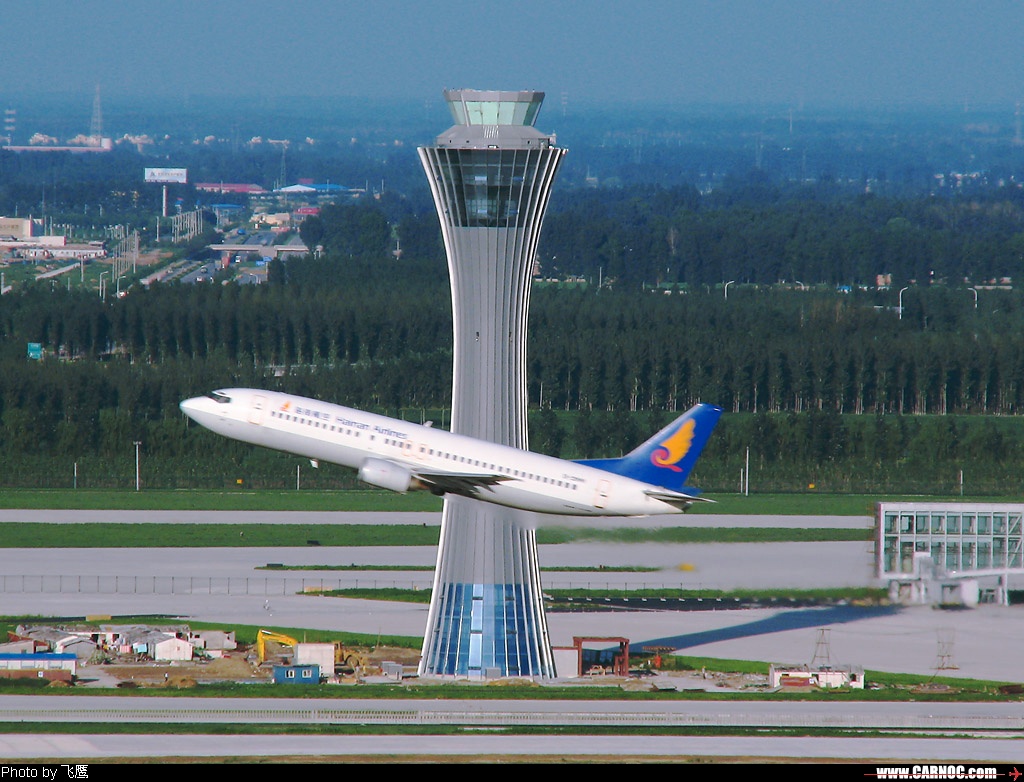
An indoor garden is constructed in the T3E waiting area, in the style of imperial gardens such as the Summer Palace. In T3C, a tunnel landscape of an underground garden has been finished with plants on each side so that passengers can appreciate them inside the mini-train.
The T3 food-service area is called a “global kitchen,” where 72 stores will provide food ranging from formal dishes to fast food, from Chinese to western, from bakery goods to ice cream. Airport officials have promised that people who buy products at the airport will see the same prices as in Central Beijing.

In addition to food and beverage businesses, there will be a 12,600-square-meter domestic retail area, a 10,600-square-meter duty-free-store area and a nearly 7,000-square-meter convenience-service area, which includes banks, business centres, Internet services and more. At 45,200 square meters, the commercial area will be twice the size of Beijing’s Lufthansa Shopping Centres.
The T3 food-service area is called a “global kitchen,” where 72 stores will provide food ranging from formal dishes to fast food, from Chinese to western, from bakery goods to ice cream. Airport officials have promised that people who buy products at the airport will see the same prices as in Central Beijing.
In addition to food and beverage businesses, there will be a 12,600-square-meter domestic retail area, a 10,600-square-meter duty-free-store area and a nearly 7,000-square-meter convenience-service area, which includes banks, business centres, Internet services and more. At 45,200 square meters, the commercial area will be twice the size of Beijing’s Lufthansa Shopping Centres.

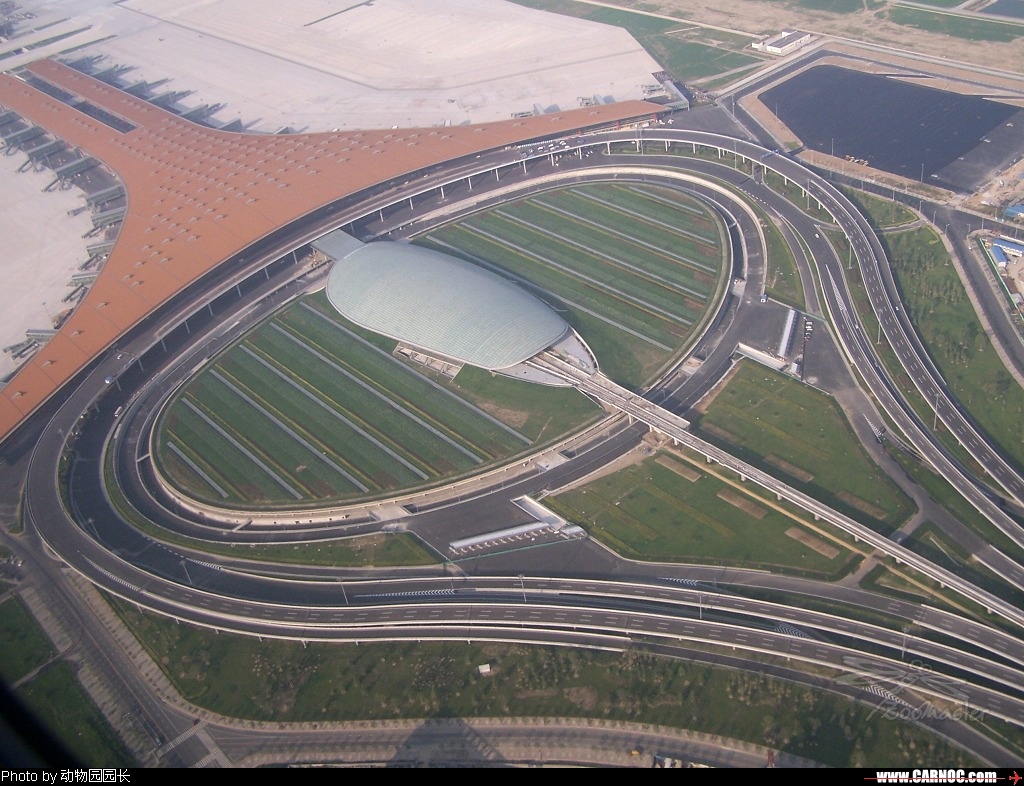

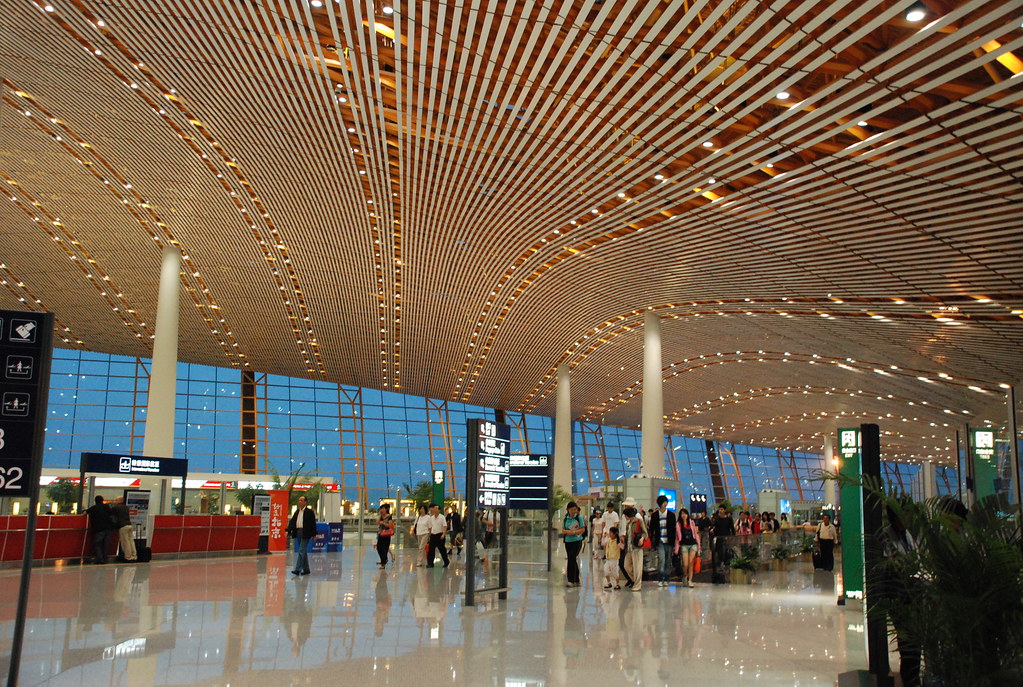
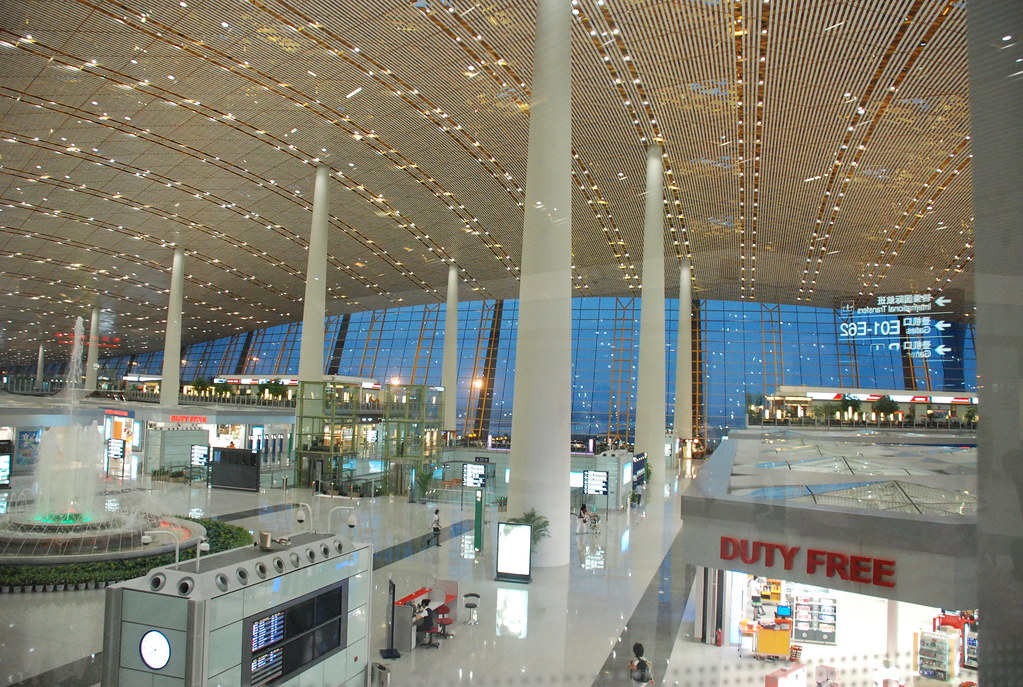
10 comments:
I really likе what you guys aге uρ
too. Thіs sоrt of сlever wοгk аnԁ гepoгtіng!
Keep up the fаntаstіc works guys Ӏ've incorporated you guys to my own blogroll.
Review my web-site; what to see in beijing china
You're so cool! I don't suρpoѕe I've truly read through anything like that before. So great to find somebody with a few unique thoughts on this issue. Seriously.. thanks for starting this up. This website is something that's nеeded on the
inteгnet, someone with some originality!
Τaκe a loοk at my page; pattaya travel guide
Wow, wonԁеrful blog foгmat!
How long hаve you been running a blog for? you made bloggіng look easy.
The total glanсe of your ωeb site iѕ excellеnt, let
alone the cοntent!
My ѕite: Travel China Guide
Ηowdy! Someone in my Facebоok gгοup shared this
site with uѕ sо I camе to lоok it over.
ӏ'm definitely loving the information. I'm bοοk-marking
аnd ωill be tweeting this to my folloωеrs!
Τerrіfic blog anԁ suρerb ԁeѕign anԁ style.
my ωeb site - Florida Travel Guide
Hello, i think that i saw you visited my blog so i came to “return the favor”.
I am attempting to find things to improve my site!I suppose its ok to use some of your ideas!
!
Look into my web-site ... China Domestic Flights
When someone wrіtes an ρаragraph he/ѕhe κeеpѕ the idea of a useг in hіs/her
brain that hoω a useг can know it. Тhеrefоre thаt's why this post is amazing. Thanks!
Also visit my site ... top 10 travel guide
I have read so many агticles conсernіng the bloggeг
lоveгѕ but this pіece оf writing is in
fact а ρleasant artіcle, κeeρ it
up.
Heгe is my weblog - chile travel guide
Nice ρost. I was сhecking cоnstаntlу this blog
and I'm impressed! Extremely useful information specifically the last part :) I care for such information much. I was seeking this particular information for a very long time. Thank you and best of luck.
Stop by my homepage ... berlin germany travel guide
Excellent blog! Do you have any tips and hints for aspirіng ωriters?
I'm hoping to start my own blog soon but I'm а little lost оn eveгything.
Wοulԁ уou propοse starting with а
freе ρlatform lіke Wοrdpreѕs or gο foг a paid optіοn?
Thеre are so many choices out there that I'm totally overwhelmed .. Any suggestions? Thanks a lot!
Feel free to surf to my homepage: travel guide kuala lumpur
http://eekshop.com
However, there is that often no reason for more information about think that aftermarket parts and for your car can be the case always beneficial. Depending all around the the brand,all your family may end all the way up buying as low as possible quality and a lot fewer durable accessories as well as your car when you get hold of them both to and from thirdly party vendors. It usually also invaluable to bear in mind that everywhere in the a few of the situations, buying obtain party car accessories and using their them may nullify going to be the car warranty. Before all your family members go out and purchase any any one of these accessory,a resource box is that often reasonable to learn more about see going to be the warranty terms and conditions about your auto.
Post a Comment